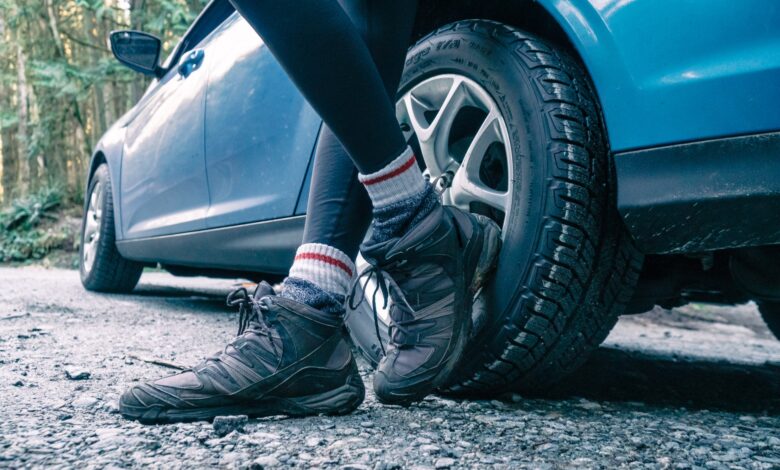
“Come on, all these years, we’ve seen hikers killing it in rough hiking boots.“
If this is what you thought after reading the title, let me introduce you to an interesting concept called the availability heuristic. According to this, we assume something is more common only because it comes to our mind easily.
Contrary to popular belief, experienced hikers don’t prefer hiking boots. As a hiker, you should ditch them too, and here’s why.
Waterproof Is Not Everything
Think your waterproof shoes will keep your feet completely dry? The joke’s on you.
Wearing waterproof shoes doesn’t stop your feet from sweating.
To be honest, feet will sweat more profusely in waterproof shoes than non-waterproof ones due to the lack of breathability.
The stench and the sweat will make you realize that those advertising claims of no perspiration are plain lies.
Secondly, waterproof shoes are waterproof only to some degree. The coating wears off after a few uses and water will find its way to your feet. To prevent this, you must re-waterproof them regularly. But no matter how good your DIY skills are, it’s never going to be as good as new.
Let’s say you’re walking across a stream full of water wearing your waterproof shoes. If the water level is too high, it can get into your shoe from the top, making your attempts futile.
The worst part, if water ever enters your shoe, it’s not going to drain out by itself, thanks to the waterproof fabric around it. You’ll have to take a break from your hike, pour the water out and let them dry completely before resuming. At this point, you’ll start to regret falling for the ‘waterproof’ trap.
Twisted Ankles
You’ve probably heard about the ‘ankle support’ myth but never paid enough attention to it. The myth says a high-topped boot (like hiking boots) provides support to the ankle and prevents injuries.
The truth is, a high-topped boot limits the movement of the foot which results in minimal strain to the ankle. The ankle doesn’t get any support but is protected from injuries.
However, you’re likely to experience pain due to a twisted ankle when you switch to low-topped boots after returning from your trip. This phase can sometimes start early on the third or fourth day of your trip while you’re still hiking in high-topped boots. Nothing ruins your hike like a sore ankle.
Therefore, walking in hiking boots has nothing to do with ankle support. Personally, I feel using ankle braces along with regular shoes is a better method to protect ankles while hiking.
Scientific research says the only sure way to support your ankles is to stretch and strengthen them. So, instead of worrying about the right kind of hiking boots, we better get into training mode.
High Cost
Hiking boots are expensive and buying them should be considered as an investment. But this isn’t the only thing that bothers me.
The maintenance of hiking boots can be intimidating for beginners and experts alike.
If you don’t clean your boots regularly, the dirt can cause cracks on the outer layer. And simple dusting won’t do justice to these costly beauties. You’ll have to buy a nice cleaning gel for the debris stuck on the outer surface.
Most of the hiking boots are made of full-grain leather which needs to be conditioned regularly to prevent flaking. Of course, every nook and corner must be conditioned generously (without going over the top).
Despite all these maintenance efforts you put into your shoes, they may need to be replaced after traveling 800 miles. Well, there are very few hiking boots in the market with promising durability. So, the breakdown point could be less than 800 too.
Are hiking boots worth this money? You decide!
Flexibility Is A Joke
Before we talk about hiking boots, in particular, let’s take a look at what flexibility means for your feet.
The flexibility of shoes plays a far bigger role in the comfort and safety of your feet than you might think. Especially in strenuous activities like walking on a trail, your feet’s natural movements shouldn’t be restricted way too much. So, shoes with good dorsiflexion (flexibility at the ball of the foot) are the comfiest ones.
Another factor to consider is torsional flexibility. Shoes scoring high on this factor put you at an increased risk for injury. The stiffer the better!
Hiking boots don’t have torsional flexibility which is a good thing for the uneven terrain on the trail, but they have less flexibility in the other points as well. This can ultimately put extra strain on your feet.
Running shoes (and some hiking shoes – not boots) offer a better balance in terms of flexibility.
Heavy On The Feet
Since hiking boots are designed to withstand harsh conditions, they have a thick sole and weigh more than hiking shoes. For someone new to the world of hiking, wearing such boots can result in leg pains.
Unless you’re hiking on an extremely rough trail, you don’t have to force the boots’ weight on your feet. Plus, don’t you think those bulky boots feel so unnatural?
A thumb rule of backpacking says one pound on your feet equals five pounds on your back and it also burns an extra five percent of energy.
Why waste this energy on heavy boots when you can use it to carry some extra food and water in your backpack?
You can learn more about finding the best hiking backpack on this blog post.
Conclusion
I hope this post shed light on the reality of hiking boots and gave you a new perspective. Remember, a journey of a thousand miles begins with a fabulous pair of shoes.
Author Bio
Starting at a young age, Res Marty’s first hikes were day trips in Switzerland and soon he started to go on multiple-day vacations on weekends. He shares his passion for traveling on his blog – ResMarty.com. Additionally, he also provides honest product reviews for all kinds of hiking equipment.
Source link






